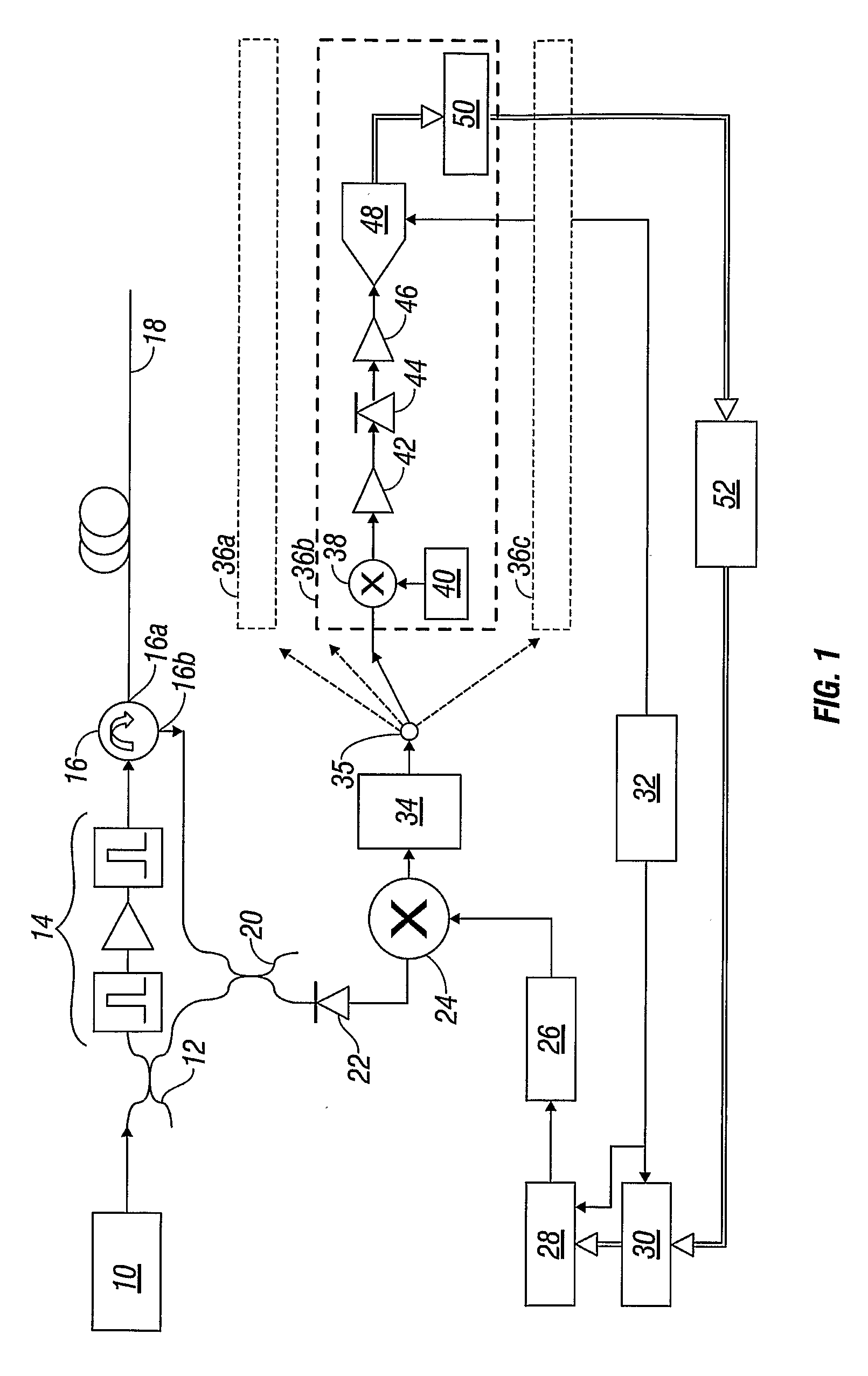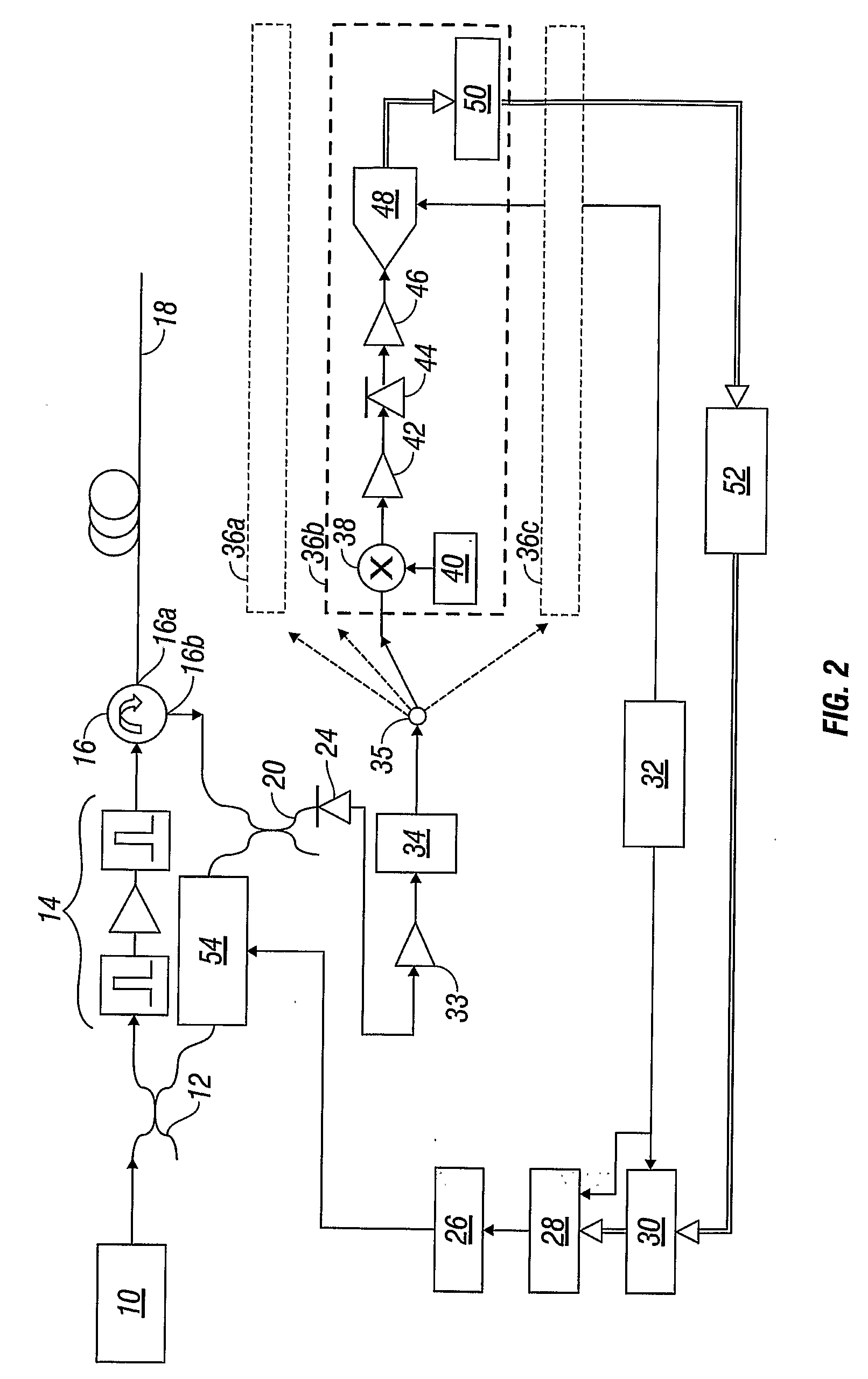Measuring brillouin backscatter from an optical fibre using a tracking signal
- Summary
- Abstract
- Description
- Claims
- Application Information
AI Technical Summary
Benefits of technology
Problems solved by technology
Method used
Image
Examples
first example embodiment
[0037]FIG. 1 shows a schematic representation of apparatus for implementing a measurement method according to an embodiment of the present invention.
[0038]An optical source 10 operable to generate narrow-band coherent light (such as a laser) produces an output beam at a frequency f0. The beam is directed into a beam splitter 12 (such as a 3 dB fibre splitter) that divides the output beam into a first part for launching into a deployed optical fibre, and a second part to be mixed with light received back from the fibre. The first part passes through a pulse forming unit 14 that produces optical probe pulses of a desired repetition frequency, pulse duration and power, suitable for probing of the deployed fibre to obtain Brillouin backscatter. In this example the pulse forming unit 14 comprises two pulse generators / gates with an amplifier between; any required combination of optical components can be used to create the necessary output, though. The pulses at f0 are then sent to an opti...
second example embodiment
[0057]FIG. 2 shows a schematic representation of a second embodiment of apparatus according to the present invention. Like reference numerals are used for like components as compared to FIG. 1.
[0058]The second embodiment employs the same arrangement as FIG. 1 for generating and launching probe pulses in an optical fibre 18, using an optical source 10 whose output is gated and amplified to produce pulses, and launched into the fibre 18 via a circulator 16. Again, the returning Brillouin light is received at the fibre end and passed by the circulator to a beam combiner 20.
[0059]Also, the acquisition and processing components are the same as in FIG. 1. The difference frequency signal ΔF(t) is passed through a bandpass filter 34 before being divided between a plurality of parallel frequency channels 36 which produce digitised samples that are delivered from an array of memory units 50 to a processor 52.
[0060]Again as in FIG. 1, the processor 52 is further connected to a memory array 30 ...
third example embodiment
[0068]An alternative to the frequency channel acquisition approach described with regard to the first and second example embodiments is an all-digital acquisition approach which employs an analog-to-digital converter to acquire the difference signal at a rate sufficient to carry out a frequency analysis. This approach may be applied to either the electrical mixing technique of the first example embodiment or the optical mixing approach of the second example embodiment.
[0069]FIG. 3 shows a schematic representation of apparatus that uses all-digital acquisition, described only for the purposes of example in conjunction with the electrical frequency mixing approach of FIG. 1 (all-digital acquisition being equally applicable to other electrical mixing arrangements, and to optical mixing including that of FIG. 2). Hence FIG. 3 shows many features in common with FIG. 1, including the pulse generation and launch components, the intermediate difference frequency mixing in the optical detect...
PUM
 Login to View More
Login to View More Abstract
Description
Claims
Application Information
 Login to View More
Login to View More - R&D
- Intellectual Property
- Life Sciences
- Materials
- Tech Scout
- Unparalleled Data Quality
- Higher Quality Content
- 60% Fewer Hallucinations
Browse by: Latest US Patents, China's latest patents, Technical Efficacy Thesaurus, Application Domain, Technology Topic, Popular Technical Reports.
© 2025 PatSnap. All rights reserved.Legal|Privacy policy|Modern Slavery Act Transparency Statement|Sitemap|About US| Contact US: help@patsnap.com



